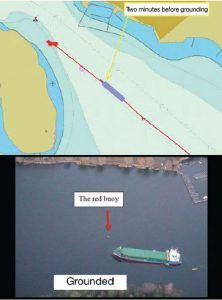A small bulk carrier was loaded and underway under pilotage in coastal confined waterways in the early morning hours. The pilot had his portable pilot unit (PPU), which was loaded with the applicable charts for the voyage. The vessel, however, did not have the paper charts on board for that area, nor was the vessel equipped with an ECDIS.
The bridge was manned by an OOW and the pilot. At 04.31 the pilot informed the OOW that about half an hour remained before they would reach their destination; the Master came back up on to the bridge at about this time. The pilot set the course to 309° on the autopilot, steering in the direction of the red buoy ahead, which was the location of the next course alteration to port.
The pilot began reducing speed and simultaneously switched over to manual steering. After a few minutes, the pilot discovered that the vessel was on the wrong side of the buoy. He was not able to turn but stopped the engine before the vessel ran aground at about 04.50.

Image Credit: nautinst.org
Among other findings, the official investigation learned that:
- The vessel lacked charts for the intended voyage, meaning that it was not seaworthy according to applicable regulations and the shipping company’s ISM scheme.
- No voyage plan had been completed, which coincided with the lack of charts.
- Bridge co-operation (BRM) before the grounding was limited, with very little communication and no participation by ship’s crew.
- At the time of the grounding, it is probable that the pilot’s level of alertness had been adversely affected by fatigue as a result of cumulative sleep deficit, the time of day, the long pilotage and the lack of opportunities for rest and recovery.
Lessons Learned
- Do not undertake a voyage without the proper charts and a detailed voyage plan.
- Actively participate in pilotage: check the position, watch the helm orders, maintain situational awareness.
Reference: nautinst.org


















